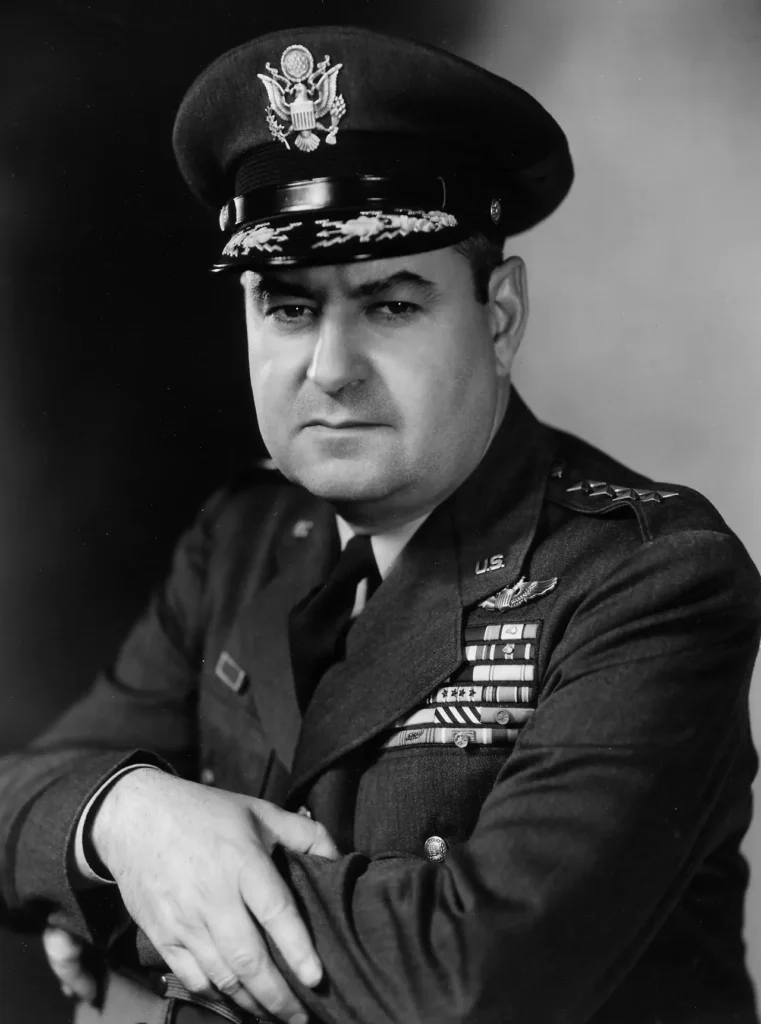
Curtis E. LeMay was one of the most prominent U.S. military leaders of the 20th century. From his pioneering work in bombing techniques during WWII to his role in shaping the United States Air Force and Cold War policy.
Let’s dive right into this brief LeMay biography!
Early Life and Education
Curtis E. LeMay was born on November 15, 1906, in Columbus, Ohio. After graduating from his local high school, he pursued a B.S. in Civil Engineering at Ohio State University in 1927. As an honor graduate with an ROTC commission, LeMay failed to obtain a congressional appointment to West Point and consequently could not attend flight school. However, after discussing his situation with the Ohio National Guard Commander, he quickly started Aviation Cadet training at March Field, California in November 1928, and received his wings at Kelly Field, Texas on October 27, 1929.
World War II Service
LeMay emerged as one of the most prominent leaders of the 2nd Bombardment Group. He became the fourth commander of the 305th Bombardment Group, a B-17 unit, and guided them to England between August and September 1942. He was in charge of the group from June 2, 1942, to May 18, 1943, during which he developed innovative bombing techniques to enhance accuracy. Subsequently, he commanded the 4th Bombardment Wing at Camp Blainey, England from June 18 to September 14, 1943.
Promoted to brigadier general, LeMay headed the 3rd Bombardment Division in England from September 13, 1943, to June 21, 1944. He removed B-24s from the mixed unit and converted the division into an exclusive B-17 organization due to performance disparities between the aircraft types. LeMay led the well-known Regensburg shuttle mission on October 17, 1943, which departed from England and landed in North Africa.

After being promoted to major general in March 1944, LeMay commanded the XX Bomber Command in the China-Burma-India Theater from August 29, 1944, to January 20, 1945, where they deployed the first B-29s against targets in Japan. He then commanded the XXII Bomber Command at Harmon Field, Guam from January 20, 1945, to July 16, 1945, and subsequently the Twentieth Air Force from July 16 to August 2, 1945.
Post-World War II Achievements
Following World War II, LeMay organized and participated in numerous record-breaking B-29 flights from the Pacific to bases in the United States. In 1947, he became the first Deputy Chief of Air Staff for Research & Development before assuming command of the United States Air Forces in Europe (USAFE) as a lieutenant general on October 20, 1947. During his tenure, he directed the Berlin Airlift, appointing Major General William H. Tunner, a strategic and experienced logistician, to oversee humanitarian airlift operations.
Strategic Air Command and Promotion to General
On October 19, 1948, LeMay became the second commander of the Strategic Air Command (SAC) and held this position until June 30, 1957. He was promoted to general on October 29, 1951, and led SAC through its transformation into an all-jet force, establishing it as the world’s foremost airpower instrument. In July 1957, General LeMay became the Air Force Vice Chief of Staff, supervising missile and space programs.

Air Force Chief of Staff and Retirement
LeMay was appointed Air Force Chief of Staff on July 1, 1961. Initially, he was assigned for two years, but President John F. Kennedy extended his term for an additional year, and President Lyndon B. Johnson further extended it until April 8, 1964. During this period, LeMay exercised restraint in expressing his opinions to maintain some influence over Air Force policies, as he was aware of the actions of then-Secretary of Defense Robert StrangeMcNamara.
General Curtis E. LeMay retired from the Air Force on February 1, 1965, after a distinguished career marked by significant contributions to the development of airpower, strategic thinking, and the advancement of the United States Air Force.
Key Takeaways
- Curtis E. LeMay was born in Columbus, Ohio, in 1906 and earned a B.S. in Civil Engineering from Ohio State University in 1927.
- LeMay became an Aviation Cadet in 1928 and earned his wings in 1929, eventually becoming a leader in the 2nd Bombardment Group.
- During WWII, LeMay commanded the 305th Bombardment Group and pioneered new bombing techniques, improving accuracy.
- LeMay held various leadership positions throughout the war, including commanding the 4th Bombardment Wing, 3rd Bombardment Division, and the XX and XXII Bomber Commands.
- After WWII, LeMay orchestrated record B-29 flights and became the first Deputy Chief of Air Staff for Research & Development in 1947.
- LeMay played a crucial role in directing the Berlin Airlift as the commander of the United States Air Forces in Europe (USAFE).
- As the second commander of the Strategic Air Command (SAC), LeMay led its transition into an all-jet force, making it a premier airpower instrument.
- LeMay served as Air Force Vice Chief of Staff, overseeing missile and space programs, and later became Air Force Chief of Staff until his retirement in 1965.
Bibliography
- A Cold War Legacy: A Tribute to Strategic Air Command, 1946-1992 by Alwyn T. Lloyd